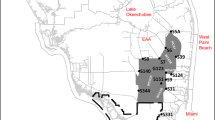Abstract
Organic chemicals unique to sewage effluent can be useful as markers of an effluent plume. Samples were collected at a domestic wastewater outfall near Cocoa, Florida, and chemically characterized. Receiving waters were analyzed to determine the chemical components in the effluent most suitable for the assessment. The saturated hydrocarbon fraction and sterol fraction appeared to be of greatest utility for such purposes, and the concentrations of these fractions were determined for water, particulate matter, and sediment. Concentrations of the marker compounds decreased rapidly with increasing distance from the outfall.
Similar content being viewed by others
References
Brown RC, Wade TL (1984) Sedimentary coprostanol and hydrocarbon distribution adjacent to a sewage outfall. Water Res 18(5):621–632
Englinton B, Hamilton RJ (1967) Leaf epicular waxes. Science 156:1322–1335
Evink GL (1980) Studies of causeways in the Indian River, Florida. Department of Transportation, Bureau of Environment, Report FL-ER-80, Tallahassee, FL. p 47
Gearing P, Gearing JN, Lyttle TF, Lyttle JS (1976) Hydrocarbons in 60 Northeast Gulf of Mexico shelf sediments: A preliminary survey. Geochim Cosmochim Acta 40:1005–1018
Han J, McCarthy ED, Van Hoeven W, Calvin M, Bradley WH (1986) A preliminary report on the distribution of aliphatic hydrocarbons in algae, in bacteria, and in recent lake sediment. Proc NAS 59(28):29–33
Hatcher PG (1978) The organic geochemistry of Mangrove Lake, Bermuda. NOAA professional paper 10 AOML. Miami, FL
Hatcher PG, McGillivary PA (1979) Sewage contamination in the New York Bight. Coprostanol as an indicator. ES&T Res. 13(10):1225–1229
Holm SE (1986) Tracing sewage effluent in coastal areas by chemical monitoring. Florida Institute of Technology, Melbourne, Florida. 79 pp
Morel FMM, Schiff SC (1980) Geochemistry of municipal waste in coastal water. Report No. 259 Dept of Civil Engineering, MIT, Cambridge, 205 pp
Murtaugh JJ, Bunch RL (1967) Sterols as a measure of fecal pollution. WPCF 39(3):404–409
Palacas JG, Love AH, Gerilla TM (1972) Hydrocarbons in estuarine sediments of Choctawhatchee Bay, Florida, and their implications for genesis of petroleum. Bull Am Assoc Petrol 56:1402–1418
Pierce RH, Brown RC (1984) Coprostanol distribution from sewage discharge into Sarasota Bay, Florida. Bull Environ Contam Toxicol 32:75–79
Shigenaka G, Price JE (1988) Correlations of coprostanol to organic contaminants in coastal and estuarine sediments of the United States. Water Resources Bulletin 24:5, 989–998
Van Vleet ES, Quinn JG (1977) Input and fate of petroleum hydrocarbons entering the Providence River and Upper Narragansett Bay from wastewater effluents. Environ Sci Technol 11:1086–1092
Yde M, DeMaeyer-Cleempoel S (1982) Coprostanol and bacterial indicators of faecal pollution in the Scheldt estuary. Bull Environ Contam Toxicol 28:129–134
Author information
Authors and Affiliations
Rights and permissions
About this article
Cite this article
Holm, S.E., Windsor, J.G. Exposure assessment of sewage treatment plant effluent by a selected chemical marker method. Arch. Environ. Contam. Toxicol. 19, 674–679 (1990). https://doi.org/10.1007/BF01183983
Received:
Revised:
Issue Date:
DOI: https://doi.org/10.1007/BF01183983




